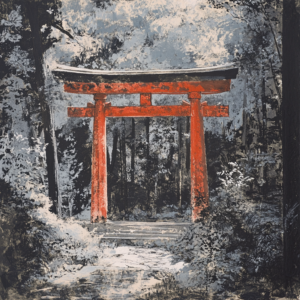Introduction
Shinto, often translated as “the way of the gods,” is Japan’s ancient spiritual tradition, deeply rooted in the country’s culture and natural landscape. As Japan’s indigenous belief system, Shinto predates recorded history and embodies a worldview centered on harmony with nature and the reverence of kami—sacred spirits present in natural phenomena, ancestors, and significant places. Though it evolved alongside Buddhism and modern influences, Shinto remains a vibrant and integral part of Japanese identity, offering timeless lessons on living harmoniously with the world.
Origins and Foundations
Shinto’s origins are woven into the fabric of Japan’s earliest societies, embodying The Indigenous Spirit of Japan. Emerging from prehistoric animistic traditions, it developed as a way for early communities to connect with the forces of nature and the divine. Unlike many organized religions, Shinto has no single founder, sacred scripture, or centralized doctrine. Instead, its practices and beliefs are passed down through oral tradition and rituals, deeply intertwined with the rhythms of daily life.
The term “Shinto” arose in the 6th century as a way to distinguish indigenous practices from the newly introduced Buddhism. Despite this distinction, Shinto’s core elements—reverence for nature, rituals of purification, and festivals—have remained consistent throughout its history.
Key Features of Shinto
- Kami (Sacred Spirits): At the heart of Shinto is the concept of kami, spiritual entities that inhabit natural elements, ancestors, and deified heroes. Kami are not omnipotent gods but are instead seen as forces that influence the world and require respect and harmony. Examples include Amaterasu (the sun goddess) and Fujisan (Mount Fuji, revered as a sacred being).
- Ritual Purity: Purity is a central theme in Shinto. Practices such as misogi (ritual purification through water) cleanse individuals of physical and spiritual impurities. These rituals highlight the importance of maintaining balance and cleanliness to foster harmony with the kami.
- Nature Worship: Shinto emphasizes a profound respect for the natural world, viewing elements like mountains, rivers, trees, and rocks as sacred manifestations of kami. Shrines are often built in places of natural beauty, blending seamlessly with their surroundings.
- Festivals (Matsuri): Shinto festivals, or matsuri, celebrate the kami and foster unity between humans and the spiritual realm. These events often include rituals, processions, music, and communal gatherings, serving both spiritual and social purposes.
- Shrines (Jinja): Shinto shrines are sacred spaces where kami are enshrined. Marked by torii gates, these places serve as focal points for worship, rituals, and festivals. They embody the connection between the spiritual and physical worlds.
Shinto’s Role in Japanese Society
Shinto has played a significant role in shaping Japan’s cultural and societal fabric. Its influence is evident in traditions, festivals, and daily practices, often interwoven with Buddhism and modern life.
- Coexistence with Buddhism: Shinto and Buddhism have coexisted in Japan for over a millennium. This syncretic relationship is exemplified by the practice of holding Shinto weddings and Buddhist funerals, reflecting a pragmatic and harmonious approach to spirituality.
- Meiji Restoration and Nationalism: During the Meiji Restoration (1868–1912), Shinto was institutionalized as a state religion to promote nationalism and imperial authority. This era saw the elevation of Shinto to a political tool, emphasizing loyalty to the emperor as a divine figure. After World War II, State Shinto was abolished, returning the tradition to its local and community-centered roots.
- Community and Local Identity: Shinto’s practices are deeply embedded in local communities, with shrines serving as cultural hubs. Seasonal festivals and rituals reinforce community bonds, preserving cultural heritage across generations.

Modern Relevance of Shinto
In the contemporary world, The Indigenous Spirit of Japan—Shinto—continues to offer insights and practices that resonate with global challenges and individual well-being:
- Harmony with Nature: Shinto’s reverence for nature encourages sustainable living and ecological consciousness. In an age of environmental crises, its principles inspire individuals and communities to respect and protect the natural world.
- Ritual and Mindfulness: Shinto rituals foster mindfulness and a connection to the present moment. Practices like visiting a shrine or performing purification rites offer moments of reflection, grounding individuals amidst the busyness of modern life.
- Cultural Preservation: Shinto festivals and traditions serve as living reminders of Japan’s rich cultural heritage. They provide a sense of continuity and identity in an era of rapid change and globalization.
- Spiritual Inclusivity: Shinto’s non-dogmatic nature allows for coexistence with other belief systems, offering a model of spiritual inclusivity and mutual respect.
Embrace the power of cultivating high morals to guide and strengthen yourself.
Lessons from Shinto in the Modern World
- Respect for the Environment: Shinto teaches that nature is not a resource to be exploited but a sacred realm to be revered and protected. This perspective encourages practices like conservation, sustainable development, and mindful consumption.
- Community and Connection: Shinto’s emphasis on festivals and local shrines highlights the importance of community and shared experiences. In a world increasingly characterized by isolation, these practices offer a blueprint for fostering connection and belonging.
- Balancing Tradition and Modernity: Shinto exemplifies how ancient traditions can adapt to contemporary contexts without losing their essence. This adaptability provides a model for preserving cultural identity in a rapidly changing world.
- Simplicity and Ritual: Incorporating simple rituals into daily life—such as pausing to reflect or offering gratitude—can cultivate mindfulness and a sense of the sacred in ordinary moments.
Shinto in Practice Today
Shinto, embodying The Indigenous Spirit of Japan, remains a vibrant tradition in modern Japan, with its practices evident in daily life, architecture, and popular culture. Visitors to Japan often encounter its influence in iconic torii gates, serene shrine landscapes, and seasonal festivals.
- Shrine Visits: Millions of people visit Shinto shrines annually, especially during New Year’s celebrations (hatsumode) and life events like weddings, births, and exams. These visits provide opportunities for prayer, reflection, and gratitude.
- Environmental Practices: Shinto’s principles have inspired initiatives like forest preservation and community-driven environmental projects, aligning with global efforts to combat climate change.
- Global Interest: As awareness of mindfulness, sustainability, and spirituality grows, Shinto’s teachings are gaining interest beyond Japan. Its practices and principles resonate with individuals seeking a deeper connection to nature and the sacred.
Conclusion
Shinto, embodying The Indigenous Spirit of Japan, offers timeless wisdom rooted in harmony, reverence, and community. Its focus on the sacredness of nature, the importance of ritual, and the interconnectedness of life remains profoundly relevant in today’s world.
In embracing Shinto principles, we are reminded of the value of simplicity, gratitude, and mindfulness. Whether through a quiet moment at a shrine, a celebration of the changing seasons, or an act of environmental stewardship, Shinto encourages us to honor the sacred in all aspects of life. As a bridge between the ancient and the modern, Shinto continues to inspire and guide, offering a path to deeper connection and balance in an ever-changing world.

